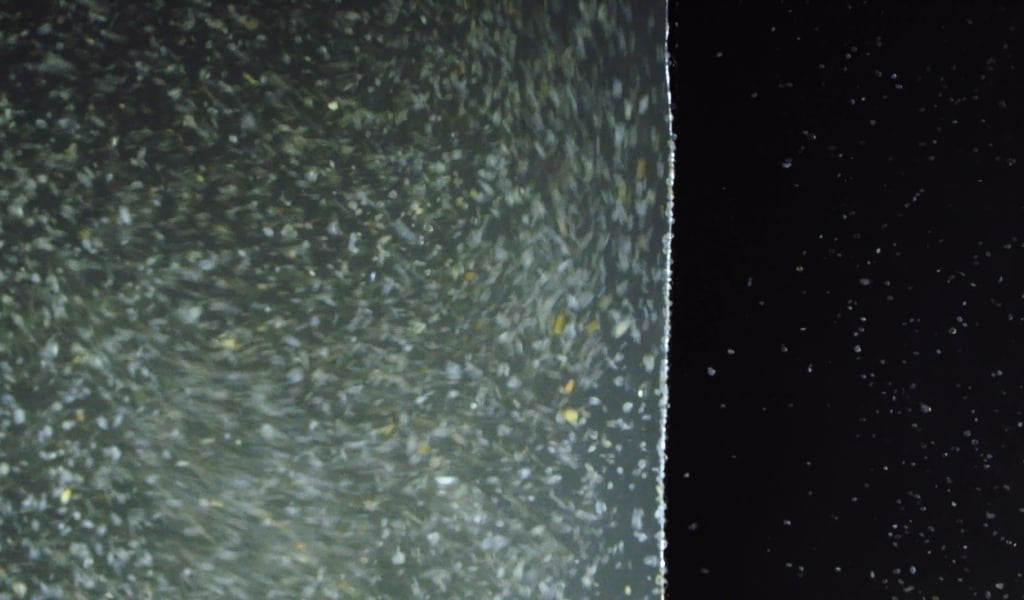Biofouling in Desalination: Causes, Consequences, and Solutions
Desalination systems, particularly those utilizing reverse osmosis (RO), are vital for addressing global water scarcity. However, these systems are highly susceptible to biofouling, which is a process in which microorganisms such as bacteria, algae, and fungi accumulate on filtration surfaces, forming resilient biofilms. This microbial buildup can severely hinder system performance, leading to increased energy consumption, reduced membrane lifespan, and operational downtime that costs you money.
For facilities operating in coastal or high-nutrient environments, biofouling is not just a nuisance, it’s a persistent threat to efficiency and reliability.
To combat biofouling, desalination plants must implement robust pre-filtration strategies that minimize biological load before water reaches sensitive RO membranes. Woven wire mesh, particularly when integrated into automatic self-cleaning filter systems, offers a durable and effective solution. Engineered from corrosion-resistant alloys such as stainless steel or high-alloys such as AVESTA 254 SMO, 904L, and Duplex, wire mesh filters can remove particles as small as 5 microns absolute and 1 micron nominal while withstanding harsh marine conditions.
When paired with cleaning mechanisms like backflushing, these filters maintain stable differential pressure and reduce manual maintenance, ultimately lowering operational costs.
At W.S. Tyler, our mission is to help desalination facilities operate cleaner and safer through innovative woven wire mesh solutions backed by over 150 years of experience. Our filtration products are designed to perform reliably in corrosive, high-load environments, ensuring consistent water quality and protecting downstream equipment. By combining precision engineering with advanced materials and coatings, we deliver filtration systems that not only meet but exceed industry standards for durability and performance.
In this article we’ll explore the root causes of biofouling in desalination systems, including biological, environmental, and material-based factors. We’ll then examine the operational consequences of biofouling, such as reduced throughput and increased maintenance demands. Finally, we’ll outline proven prevention strategies, with a focus on how woven wire mesh and advanced coatings can be leveraged to enhance system resilience. Whether you’re designing a new plant or optimizing an existing one, this guide will provide the technical insights needed to make informed decisions.
What Causes Biofouling in Desalination Systems?
Biofouling in reverse osmosis (RO) desalination systems begins when microorganisms such as bacteria, algae, and fungi adhere to membrane surfaces and system components. These organisms secrete extracellular polymeric substances (EPS), forming biofilms that are highly resistant to cleaning and disinfection.
Thin-film composite (TFC) membranes, commonly used in RO systems, are particularly vulnerable due to their rough, hydrophobic surfaces and the presence of carboxylic groups that promote microbial attachment. Once established, biofilms reduce membrane permeability and increase transmembrane pressure, leading to higher energy consumption and reduced throughput.
Environmental conditions such as warm temperatures, high nutrient loads, and stagnant flow zones accelerate biofouling. Operational shortcomings like inadequate pretreatment, inconsistent cleaning schedules, and poor system design further exacerbate the issue. For example, insufficient removal of dissolved organic carbon during pretreatment allows microbial communities to flourish. Additionally, the chlorine sensitivity of polyamide membranes limits the use of oxidizing disinfectants, making biofouling control more complex.
The materials used in pre-filtration systems significantly influence biofouling risk. Woven wire mesh, when manufactured from high-performance alloys such as Duplex stainless steel, 904L, or AVESTA 254 SMO, offers superior resistance to corrosion and microbial colonization. These alloys resist pitting and crevice corrosion caused by chloride ions in seawater, which can otherwise create surface irregularities that trap organic matter.
Additionally, surface coatings can inhibit microbial growth and enhance cleanability, making wire mesh a strategic choice for biofouling prevention.
Woven wire mesh is commonly used in automatic self-cleaning filters as a pre-filtration stage in RO desalination systems. These filters remove particulates and biological matter before water reaches sensitive membranes, reducing biofouling potential. The mesh’s uniform pore structure enables precise filtration down to 5 microns absolute and 1 micron nominal, while its surface-filtering nature allows for efficient backflushing and mechanical cleaning.
When paired with self-cleaning mechanisms, wire mesh filters maintain low differential pressure and minimizes manual intervention, helping facilities reduce downtime and cost of ownership.
The Impact of Biofouling on Desalination Efficiency
Biofouling significantly impairs the performance of reverse osmosis (RO) desalination systems. As biofilms accumulate on membrane surfaces, they increase transmembrane pressure (TMP) and hydraulic resistance, forcing pumps to work harder to maintain throughput. This results in elevated energy consumption and reduced water recovery rates.
In severe cases, biofouling can lead to concentration polarization, where solute buildup near the membrane surface further degrades water quality and increases osmotic pressure. These effects compound over time, making biofouling one of the most costly and persistent challenges in desalination operations.
To restore system performance, operators must frequently perform chemical clean-in-place (CIP) procedures, which involve flushing membranes with biocides and surfactants. These cleaning cycles not only consume chemicals and labor but also require system shutdowns, contributing to operational downtime.
Over time, repeated exposure to cleaning agents can degrade membrane integrity, shortening their lifespan and increasing replacement costs. Plants in high-biofouling regions often require more extensive pretreatment and larger membrane arrays, which inflate capital and operating expenses.
Interested in discovering more about the costs associated with the failures that can occur in desalination and how to alleviate these issues? Learn about it and more in our article below:
The financial impact of biofouling extends beyond maintenance. Increased energy demand raises utility costs and carbon emissions, undermining sustainability goals. Additionally, the use of aggressive cleaning chemicals poses environmental risks, especially when discharged into marine ecosystems. These factors make biofouling not only a technical issue but also a regulatory and ecological concern.
As desalination becomes more widespread, especially in water-stressed regions, minimizing biofouling is essential for long-term economic and environmental viability.
Woven wire mesh used in pre-filtration plays a critical role in reducing biofouling-related inefficiencies. By removing particulates and biological matter before they reach the RO membranes, wire mesh filters help maintain low silt density index (SDI) levels and stable operating conditions.
When integrated into automatic self-cleaning filter systems, wire mesh maintains consistent performance with minimal manual intervention. Alloys such as Duplex stainless steel, 904L, and AVESTA 254 SMO offer excellent corrosion resistance and durability in seawater environments, while surface treatments can help to further inhibit microbial colonization.
This combination of precision filtration and robust materials helps desalination plants reduce energy use, extend membrane life, and lower total cost of ownership.
Best Practices for Biofouling Mitigation
Effective biofouling mitigation begins with robust pre-filtration. Woven wire mesh, especially when integrated into automatic self-cleaning filters, acts as a frontline defense by removing suspended solids and organic matter before they reach the RO membranes.
Mesh made from 316L or high-alloys such as AVESTA 254 SMO, Duplex, and 904L offers high corrosion and mechanical strength, making it ideal for harsh seawater environments. These materials resist pitting and crevice corrosion, which can otherwise create microbial harborage points. The mesh’s surface filtration properties also allow for efficient backflushing, reducing manual cleaning and maintaining consistent flow.
Advanced coatings can significantly enhance the anti-biofouling properties of wire mesh. Copper-nickel alloys and epoxy coatings are known to inhibit microbial adhesion and biofilm formulation. Copper ions, for example, disrupt bacterial cell membranes, reducing colonization rates. Epoxy coatings provide a smooth, non-porous surface that limits nutrient acceleration and facilitates easier cleaning.
These treatments extend the service life of filtration components and reduce the frequency of chemical cleaning cycles, which can be costly and environmentally taxing.
Automatic self-cleaning filters equipped with woven wire mesh use mechanical systems like rotary brushes, suction scanners, or spiral brushes to continuously remove debris from the mesh surface. These systems operate based on differential pressure triggers, initiating cleaning cycles without interrupting flow. This not only maintains optimal filtration performance but also minimizes downtime and labor costs. Some designs can handle high total suspended solids (TSS) loads and operate at low differential pressures, making them ideal for variable seawater conditions.
Real-time monitoring tools such as pressure sensors, conductivity meters, and flow rate trackers are essential for early detection of biofouling. These systems allow operators to respond proactively, adjusting cleaning schedules or chemical dosing as needed. Regular inspection of pre-filtration components, especially mesh integrity and coating condition, ensures long-term reliability.
Combining these practices with predictive maintenance strategies can rescue operational costs and extend membrane life significantly.
Taking Action Against Biofouling in Desalination
Biofouling remains one of the most persistent and costly challenges in reverse osmosis desalination systems. From microbial adhesion and biofilm formulation to reduced membrane efficiency and increased energy demands, the consequences are far-reaching. Fortunately, understanding the root causes, whether environmental, operational, and material-based, enables plant operators to implement targeted mitigation strategies. With the right filtration technologies and maintenance protocols, biofouling can be effectively managed to ensure long-term system reliability.
Woven wire mesh, especially when used in automatic self-cleaning filters, offers a powerful solution to biofouling prevention. Its precise pore structure and mechanical strength allow for consistent removal of biological and particulate contaminants before they reach sensitive RO membranes. When fabricated from high-performance alloys and enhanced with antimicrobial coatings, wire mesh filters resist corrosion and microbial colonization even in the harshest of environments.
At W.S. Tyler, we are committed to helping desalination facilities operate cleaner and safer, backed by over 150 years of engineering experience. Our woven wire mesh solutions are designed to meet the rigorous demands of seawater filtration, offering durability, precision, and ease of maintenance. Whether you’re upgrading an existing system or designing a new plant, our filtration technologies are built to rescue downtime, lower operational costs, and extend the life of your membranes.
Looking to determine the pros and cons of woven wire mesh vs. wedge wire screens for your desalination system? Check out our article below to learn the differences and how these two can even work in conjunction to provide you with a technologically advanced process:
About Dylan Polz
Dylan is a Content Writer with 2 years of experience in marketing and SEO. Passionate about learning and strengthening his writing skills, he is currently expanding his expertise in particle analysis and woven wire mesh technologies. With a strong belief in the power of information to drive positive change, his goal is to develop content that supports cleaner, safer solutions across all industries.



